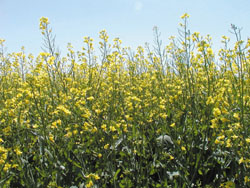
Features
Fertilizer
Seed & Chemical
Is starter P required for top canola yields?
Historically on the Canadian prairies, the best approach to applying P fertilizer was to place it directly in the seedrow. Interestingly, when the idea of applying P fertilizer was first introduced, due to equipment limitations, the only other option available was broadcasting.
January 15, 2008 By John Harapiak
Yes, especially on very P responsive sites!
Historically on the Canadian prairies, the best approach to applying P fertilizer
was to place it directly in the seedrow. Interestingly, when the idea of applying
P fertilizer was first introduced, due to equipment limitations, the only other
option available was broadcasting. At that time, prairie soils were quite deficient
in P and, under those conditions, P applied with the seed was significantly
more effective than broadcasting.
 |
| The benefit of placing some of the P in the seedrow appears to be most likely for canola that is grown on a very P responsive site. |
Equipment creates new options
During the past 15 to 20 years, manufacturers of ag-equipment have introduced
a number of fertilizer application innovations that allowed researchers and
growers to evaluate different practical options for applying P fertilizer. The
first of these was the option of pre-plant banding both N and P, either in the
fall or prior to seeding in the spring. The choices at the time of seeding that
have recently evolved include side-banding of a N-P blend near the seedrow or
else mid-row banding the N-P blend between pairs of seedrows.
Adding N creates P placement flexibility
Phosphate is notoriously immobile within the soil, thus making it difficult
for roots to locate it if placed more than an inch or so from the seedrow. Applying
P in combination with N makes it possible to gain considerable P placement flexibility.
This results from the fact that the N is more mobile, thus enabling the N to
migrate significantly out of the application band. This movement of N creates
a much larger target for the roots of the crop to intercept.
N improves root access to P
When the roots locate a zone of higher N concentration, they will quickly proliferate
in the area and thereby locate and recover the less mobile P contained within
the dual N-P band. All three of the relatively new application options mentioned
would be considerably less effective if a phosphate fertilizer, such as 11-51-0,
were to be applied alone, rather than in a blend containing a significant amount
of nitrogen.
 |
| Land use and cropping history are important factors in considering the value of fertilizer and methods of application. |
Increased residual P adds flexibility
Another reason why options other than seed placement of P fertilizer can now
be considered has been the gradual accumulation in the soil of residual P fertilizer
from applications made over the past 30 to 50 years. The net result of this
build-up is that a dramatic response to seedrow applied starter P is now less
common than was the case in the early years of testing. Without the inclusion
of N with the P, and without the build-up of residual P fertilizer, the newer
options for placing P fertilizer away from the seedrow would be less viable.
Is starter P still required?
With all these changes, the practical question frequently posed by growers is
whether it is still really necessary or beneficial to apply any of the P fertilizer
directly with the seed. The answer to this question varies with a number of
factors (see Necessary or beneficial?).
However, the benefit of placing some of the P in the seedrow appears to be most
likely for canola that is grown on a very P responsive site. These conditions
are most likely to prevail when canola is grown on fallow or especially on fields
broken out of forage production.
Starter P boosts canola yields
The information summarized in Table 1 illustrates the response of canola to
seedrow applied starter P on a very P responsive site that had been broken out
of forage production in the previous year. In this study, combinations of N
and P were applied prior to seeding, either by banding or by broadcasting. A
top yield of 52.1bu/ac was achieved by combining a banded N-P application with
seed-placed starter P. The response to an application of seedrow starter P was
5.7, 2.1 and 4.8 bushels per acre of canola, respectively, for the unfertilized
check treatment, the broadcast applied and the band applied N and P treatments.
| Table 1. Impact of seedrow applied starter P (20 pounds of P2O5 per acre) on the unfertilized check treatment and on pre-plant broadcast and band applied N and P treatments. |
||
| – |
Canola yield (bu/ac)
|
|
| Pre-seed treatment |
No starter P applied
|
Starter P applied
|
| None |
24.4
|
30.1
|
| N and P broadcast |
44.3
|
46.4
|
| N and P banded |
47.3
|
52.1
|
Splitting N and P beneficial for canola
These and other similar observations indicate that canola growers seeking to
achieve top yields should consider putting some P in the seedrow, if the option
is available. For example, splitting the application of a N-P fertilizer blend
between the seedrow and the side-band/mid-row band positions should be considered.
This practice could be especially beneficial for canola grown on soils that
are quite responsive to phosphate fertilizer. Providing limitations imposed
by soil texture and SBU considerations on seedrow N rates are not exceeded,
15 to 30 percent of the total blend could be placed in the seedrow. The benefit
of splitting the application of a fertilizer blend in this manner for cereal
crops tends to be somewhat less beneficial than for canola. -30-
Necessary or beneficial?
Factors contributing to decreased
responsiveness to P
- 30 to 50 years of regular fertilizer P applications.
- History of regular manure applications.
- Continuous crop production.
- Use of direct seeding/no-till systems that minimize soil disturbance.
- Production of cereal crops on cereal stubble.
- Soils with high soil test P levels.
- Soils that are warm and moist at time of planting.
- Recent history of limited response to fertilizer P.
Factors suggesting increased responsiveness to P
- New land breaking.
- Land broken out of long-term hay or pasture production.
- Fields with a limited history of fertilizer P application.
- Crop production on land fallowed in the previous year.
- Break in cropping sequence, eg. cereal production on canola stubble.
- Soils with low soil test P levels.
- Soils are cold and dry at the time of planting.
- History of strong visual response to fertilizer P. -30-